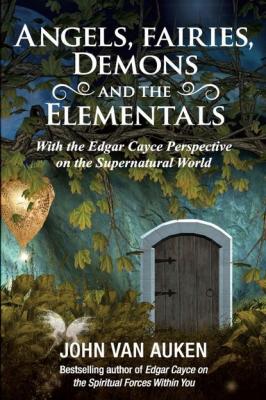ТОП просматриваемых книг сайта:
Angels, Fairies, Demons, and the Elementals. John Van Auken
Читать онлайн.Название Angels, Fairies, Demons, and the Elementals
Год выпуска 0
isbn 9780876048009
Автор произведения John Van Auken
Жанр Эзотерика
Издательство Ingram
Angels, Fairies,
Demons,
and the
Elementals
Credit: “Enchanted Tree”: © Ellerslie77/Dreamstime.com.
Angels, Fairies,
Demons,
and the
Elementals
With an Edgar Cayce Perspective on the Supernatural World
JOHN VAN AUKEN
Copyright © 2015
by John Van Auken
1st Printing, September 2015
Printed in the U.S.A.
All rights reserved. No part of this book may be reproduced or transmitted in any form or by any means, electronic or mechanical, including photocopying, recording, or by any information storage and retrieval system, without permission in writing from the publisher.
A.R.E. Press
215 67th Street
Virginia Beach, VA 23451-2061
ISBN 13: 978-0-87604-770-5
Edgar Cayce Readings ©1971, 1993-2007
by the Edgar Cayce Foundation.
All Rights Reserved.
Cover design by Christine Fulcher
Contents
4Fairies, Sprites, Elves, and More
5Reverend Kirk’s “The Secret Commonwealth”
6Excerpts from J.R.R. Tolkien’s “On Fairy Stories”
7Encounters with Little People
8Demons, Fallen Angels, and the Dark Forces
10Second Sight and the Sixth Sense
Illustrations
“Enchanted Tree”: © Ellerslie77/Dreamstime.com
“Mysterious Old Forest”: © Subbotina/Dreamstime.com
Gustave Doré: Elijah is nourished by an angel, I Kings 19
“Enchanted Elves House”: © Ellerslie77/Dreamstime.com
“Fairy Rocks and Flowers”: © Unholyvault/Dreamstime.com
John Albert Bauer (1882-1918): Trolls and the Fairy, Wikimedia
Edward Robert Hughes (1851-1914): “Midsummer Eve,” a fairy ring, Wikimedia
William Blake (1757-1827): Lucifer before the Fall
Depiction of Human Double-Helix DNA Strand from the National Institute of Standards
About Edgar Cayce
Edgar Cayce (pronounced KAY-see, the same as the English name Casey) was born on a farm near Hopkinsville, Kentucky, on March 18, 1877. As a child, he displayed unusual powers of perception. At the age of six, he told his parents that he could see and talk with “visions,” sometimes of relatives who had recently died, and on occasion he saw angels. He could also sleep with his head on his schoolbooks and awaken with a photographic recall of their contents, even citing the page number upon which the answer appeared. However, after completing seventh grade, he left school—which was not unusual for boys of his age at that time.
When he was twenty-one, he developed a paralysis of the throat muscles that caused him to lose his voice. When doctors were unable to find a physical cause for this condition, Edgar Cayce asked an acquaintance to help him re-enter the same kind of hypnotic sleep that had enabled him to memorize his schoolbooks as a child. The friend gave him the necessary suggestions, and once he was in this trance-like state, Cayce spoke clearly and directly without any difficulty. He instructed the “hypnotist” to give him a suggestion to increase the blood flow to his throat; when the suggestion was given, Cayce’s throat turned blood red. Then, while still under hypnosis, Cayce recommended some specific medication and manipulative therapy that would aid in restoring his voice completely.
On subsequent occasions, Cayce would go into the hypnotic state to diagnose bodily conditions and prescribe a course of action to restore health. Doctors around Hopkinsville and Bowling Green, Kentucky, took advantage of Cayce’s unique talent to diagnose their patients. They soon discovered that all Cayce needed was the name and address of a patient to “tune in” telepathically to that individual’s mind and body. The patients didn’t have to be near Cayce, he could tune-in to them wherever they were.
When one of the young MDs working with Cayce submitted a report on his strange abilities to a clinical research society in Boston, the reactions were ones of astonishment. On October 9, 1910, The New York Times carried two pages of headlines and pictures. From then on, people from all over the country sought the so-called “Sleeping Prophet,” a nickname that came from one of the many books written about him.
The routine he used for conducting a trance-diagnosis was to recline on a couch with his hands over his “third eye” region on his forehead. When he saw a white light, he moved his hands to his solar-plexus. At this time, his eyelids would begin fluttering, and his breathing would become deep and rhythmic. This was the signal to the conductor (usually his wife, Gertrude) to make

